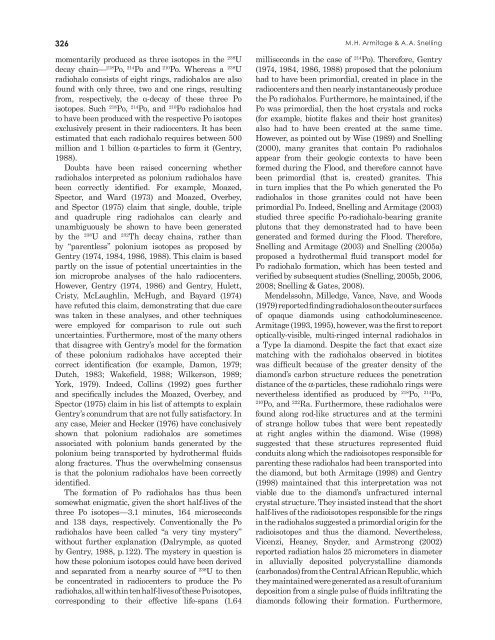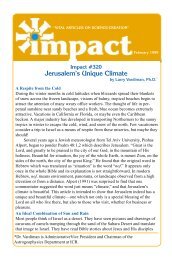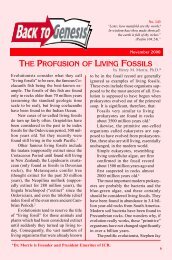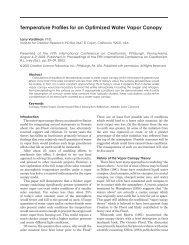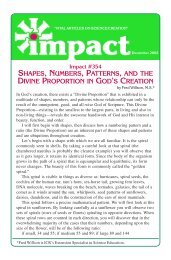Radiohalos and Diamonds - CiteSeer
Radiohalos and Diamonds - CiteSeer
Radiohalos and Diamonds - CiteSeer
You also want an ePaper? Increase the reach of your titles
YUMPU automatically turns print PDFs into web optimized ePapers that Google loves.
326momentarily produced as three isotopes in the 238 Udecay chain— 218 Po, 214 Po <strong>and</strong> 210 Po. Whereas a 238 Uradiohalo consists of eight rings, radiohalos are alsofound with only three, two <strong>and</strong> one rings, resultingfrom, respectively, the α-decay of these three Poisotopes. Such 218 Po, 214 Po, <strong>and</strong> 210 Po radiohalos hadto have been produced with the respective Po isotopesexclusively present in their radiocenters. It has beenestimated that each radiohalo requires between 500million <strong>and</strong> 1 billion α-particles to form it (Gentry,1988).Doubts have been raised concerning whetherradiohalos interpreted as polonium radiohalos havebeen correctly identified. For example, Moazed,Spector, <strong>and</strong> Ward (1973) <strong>and</strong> Moazed, Overbey,<strong>and</strong> Spector (1975) claim that single, double, triple<strong>and</strong> quadruple ring radiohalos can clearly <strong>and</strong>unambiguously be shown to have been generatedby the 238 U <strong>and</strong> 232 Th decay chains, rather thanby “parentless” polonium isotopes as proposed byGentry (1974, 1984, 1986, 1988). This claim is basedpartly on the issue of potential uncertainties in theion microprobe analyses of the halo radiocenters.However, Gentry (1974, 1986) <strong>and</strong> Gentry, Hulett,Cristy, McLaughlin, McHugh, <strong>and</strong> Bayard (1974)have refuted this claim, demonstrating that due carewas taken in these analyses, <strong>and</strong> other techniqueswere employed for comparison to rule out suchuncertainties. Furthermore, most of the many othersthat disagree with Gentry’s model for the formationof these polonium radiohalos have accepted theircorrect identification (for example, Damon, 1979;Dutch, 1983; Wakefield, 1988; Wilkerson, 1989;York, 1979). Indeed, Collins (1992) goes further<strong>and</strong> specifically includes the Moazed, Overbey, <strong>and</strong>Spector (1975) claim in his list of attempts to explainGentry’s conundrum that are not fully satisfactory. Inany case, Meier <strong>and</strong> Hecker (1976) have conclusivelyshown that polonium radiohalos are sometimesassociated with polonium b<strong>and</strong>s generated by thepolonium being transported by hydrothermal fluidsalong fractures. Thus the overwhelming consensusis that the polonium radiohalos have been correctlyidentified.The formation of Po radiohalos has thus beensomewhat enigmatic, given the short half-lives of thethree Po isotopes—3.1 minutes, 164 microseconds<strong>and</strong> 138 days, respectively. Conventionally the Poradiohalos have been called “a very tiny mystery”without further explanation (Dalrymple, as quotedby Gentry, 1988, p. 122). The mystery in question ishow these polonium isotopes could have been derived<strong>and</strong> separated from a nearby source of 238 U to thenbe concentrated in radiocenters to produce the Poradiohalos, all within ten half-lives of these Po isotopes,corresponding to their effective life-spans (1.64M. H. Armitage & A. A. Snellingmilliseconds in the case of 214 Po). Therefore, Gentry(1974, 1984, 1986, 1988) proposed that the poloniumhad to have been primordial, created in place in theradiocenters <strong>and</strong> then nearly instantaneously producethe Po radiohalos. Furthermore, he maintained, if thePo was primordial, then the host crystals <strong>and</strong> rocks(for example, biotite flakes <strong>and</strong> their host granites)also had to have been created at the same time.However, as pointed out by Wise (1989) <strong>and</strong> Snelling(2000), many granites that contain Po radiohalosappear from their geologic contexts to have beenformed during the Flood, <strong>and</strong> therefore cannot havebeen primordial (that is, created) granites. Thisin turn implies that the Po which generated the Poradiohalos in those granites could not have beenprimordial Po. Indeed, Snelling <strong>and</strong> Armitage (2003)studied three specific Po-radiohalo-bearing graniteplutons that they demonstrated had to have beengenerated <strong>and</strong> formed during the Flood. Therefore,Snelling <strong>and</strong> Armitage (2003) <strong>and</strong> Snelling (2005a)proposed a hydrothermal fluid transport model forPo radiohalo formation, which has been tested <strong>and</strong>verified by subsequent studies (Snelling, 2005b, 2006,2008; Snelling & Gates, 2008).Mendelssohn, Milledge, Vance, Nave, <strong>and</strong> Woods(1979) reported finding radiohalos on the outer surfacesof opaque diamonds using cathodoluminescence.Armitage (1993, 1995), however, was the first to reportoptically-visible, multi-ringed internal radiohalos ina Type Ia diamond. Despite the fact that exact sizematching with the radiohalos observed in biotiteswas difficult because of the greater density of thediamond’s carbon structure reduces the penetrationdistance of the α-particles, these radiohalo rings werenevertheless identified as produced by 218 Po, 214 Po,210Po, <strong>and</strong> 222 Ra. Furthermore, these radiohalos werefound along rod-like structures <strong>and</strong> at the terminiof strange hollow tubes that were bent repeatedlyat right angles within the diamond. Wise (1998)suggested that these structures represented fluidconduits along which the radioisotopes responsible forparenting these radiohalos had been transported intothe diamond, but both Armitage (1998) <strong>and</strong> Gentry(1998) maintained that this interpretation was notviable due to the diamond’s unfractured internalcrystal structure. They insisted instead that the shorthalf-lives of the radioisotopes responsible for the ringsin the radiohalos suggested a primordial origin for theradioisotopes <strong>and</strong> thus the diamond. Nevertheless,Vicenzi, Heaney, Snyder, <strong>and</strong> Armstrong (2002)reported radiation halos 25 micrometers in diameterin alluvially deposited polycrystalline diamonds(carbonados) from the Central African Republic, whichthey maintained were generated as a result of uraniumdeposition from a single pulse of fluids infiltrating thediamonds following their formation. Furthermore,


